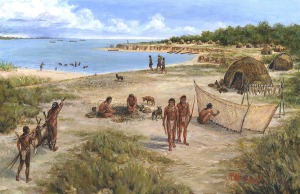By using our website, you agree to the use of cookies as described in our Cookie Policy
SOME LOST TRIBES OF TEXAS

Mrs. Julia Jones, Houston, Texas
From J. Marvin Hunter’s Frontier Times Magazine, June, 1941
Recently, there has appeared a most interesting work by Dr. John R. Swan, ton, ethnologist of Smithsonian Institute. In this work is compiled all remnants of the languages of a number of extinct Indian tribes, who disappeared from the earth about two hundred years ago, but who for a time had their parts iii making the history of Texas.
These were tribes of wandering Indians, who bore the unsavory reputation of being cannibals as well as nomads. This fact, no doubt, is what led to their extermination, for all the savage peoples, those practicing cannibalism, naturally, were the most loathed. Many of them were hunted down and massacred, while others, unfitted for changed conditions of life imposed upon them by the coming of the whites, died off in rapidly increasing numbers.
At the most, they were small, and most primitive groups, living all along the Texas Coast and extending westward along the Mexican border. They "speak a babel of tongues between which it is difficult to find any traces of relationship," wrote a Spanish explorer and mapmaker of the seventeenth century.
No record was made of the greater number of these languages. Of others, a very incomplete vocabulary was made by Spanish priests and explorers. Dr. Swanson asserts that there can be no doubt that originally, perhaps many centuries before the .coming of white men, the whole area from Texas westward was occupied by these primitive, babel, tongued peoples. The Aztec and Navajo drives toward the east cut them in two, leaving the Texas tribes squeezed against the powerful Muskogeans to the east.
These original Texans, who are being saved from complete oblivion by parts of their languages, are the Karankawans, the Coahuiltecans, the Tanma, lipecans and the Janambrians, all of whom demanded much attention during the eras when the whites were establishing dominion over the land. Our most famed mission, the Alamo, called originally `San Antonio de Valero' was built in hopes of educating and Christianizing the Coahuiltecans.
_____________________________________
_____________________________________
These four larger tribes left fair, sized vocabularies. Of others, we have a much more fragmentary record. These are the Alachoines, Parchaque, Chomes, Pamais, Mesealeros and Yorkicas. Of one tiny tribe living on the San Antonio River, only a single word, their own name, Payaya, is yet alive.
The one tribe best known to Texas pioneers and historians, was the Karankawas, a most warlike people, feared by other Indians as well as by whites. They first appeared in history in 1685, when the French explorer, La. Salle, attempted to plant a colony in their territory on the Texas coast.
After the advent of Austin's colony, in 1823, there was frequent conflict between the Karankawans and the colonists, in which the Indians lost heavily, though the whites suffered also. During the Texas Revolution, somewhat to the surprise of Texas leaders, and altogether against their wishes, the blood-thirsty savages sided with them against Mexico, though efforts were made to compel their neutrality.
In 1844, this tribe murdered a family living on the Guadalupe River, and then, to escape white vengeance, fled. Part of them escaped across the Rio Grande into Mexico. The remnant left behind found temporary refuge in one of their old retreats. Resorting to their earlier atrocities after a number of years had built up their man power, they again were hunted down by vengeful ranch owners, and well nigh exterminated, this in 1858.
Fleeing again, the tribe made its way to the Coast, and there lived as best it could for many months. Then, apparently seeing no future, they made way with the weaker members of the tribe, while the others crossed over to a sand-bar, and there invited death by starvation. This is said to be the one and only instance of group suicide by Indians.
‹ Back





Comments